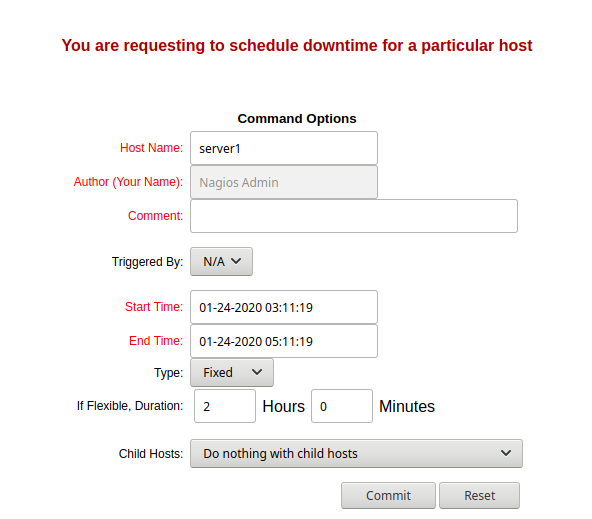Scheduled downtime in Nagios is done for a host or a service.
The Scheduling downtime is done from the web interface and or running scripts in the Nagios.
Here at Bobcares, we often receive requests regarding Nagios as a part of our Server Management Services.
Today, let’s see how our Support Engineers schedule downtime for host and service in Nagios.
Schedule downtime in Nagios for a host
Recently one of our customers contacted us to set up a scheduled downtime for a server in Nagios. Let’s discuss how we help our customers on the same.
First, we log in to the Nagios web interface.
Then we click on services in the left pane.
From the list, we click on the hostname.
Then from the Hosts commands we click on “Schedule downtime for this host”
The Host and the Author will be automatically filled. In the comment box, we enter the reason for the scheduled task.
Now we enter the Start Time and End Time of the scheduled process. The start and end time need to be specified in mm/dd/yyyy hh:mm:ss format.
Then we select the Type. There are 2 types Fixed and Flexible.
The Fixed time will start and stop at the time we specify in the schedule.
We use the Flexible type when we are not sure about the downtime. Thus, we specify the time in If Flexible, Duration:. Flexible downtime starts when the host goes down or becomes unreachable between the start and end times.
Then we mention the Child Host and Nagios needs to do with the Child process.

Once we verify the details, we click on commit to save the schedule.
Schedule downtime in Nagios for a service
First login to Nagios web interface and we click on services in the left pane.
From the list, we find the host server and click on the service to schedule it.
Then from the Hosts commands we click on “Schedule downtime for this host”
In the comment box, we enter the reason for the scheduled task.
Then we enter the Start Time and End Time of the scheduled process in the format mm/dd/yyyy hh:mm:ss.
We select the schedule type as Fixed or Flexible as per the requirement.
Then we mention the Child Host and Nagios needs to do with the Child process.
We verify the details, we click on commit to save the schedule.
A common error in scheduling downtime
Recently one of our customers contacted telling us that the scheduled time is not working for his Nagios host. Thus, on checking we found that the entry was missing in the Scheduled Downtime.
Now let’s discuss how our Support Engineers resolve the error for our customers.
Missing entry in scheduled downtime
Thus, our Support Engineers login to the server. On checking the error log we found that the below error.
[error] [client xxx.xx.xxx.xx] Couldn't resolve host 'localhost', referer: http://xx.xx.xx.xx/nagiosxi/includes/components/xicore/downtime.php
On checking the hosts file the localhost entry was missing.
Thus, we edit the hosts file and add the localhost entry.
Finally, we restart the Apache service.
service apache2 restart
[Ned any further assistance with Nagios? – We’ll help you]
Conclusion
In short, we’ve discussed how our Support Engineers schedule downtime for a host and a service. Also, we’ve discussed the common error that can occur during scheduling downtime.







0 Comments